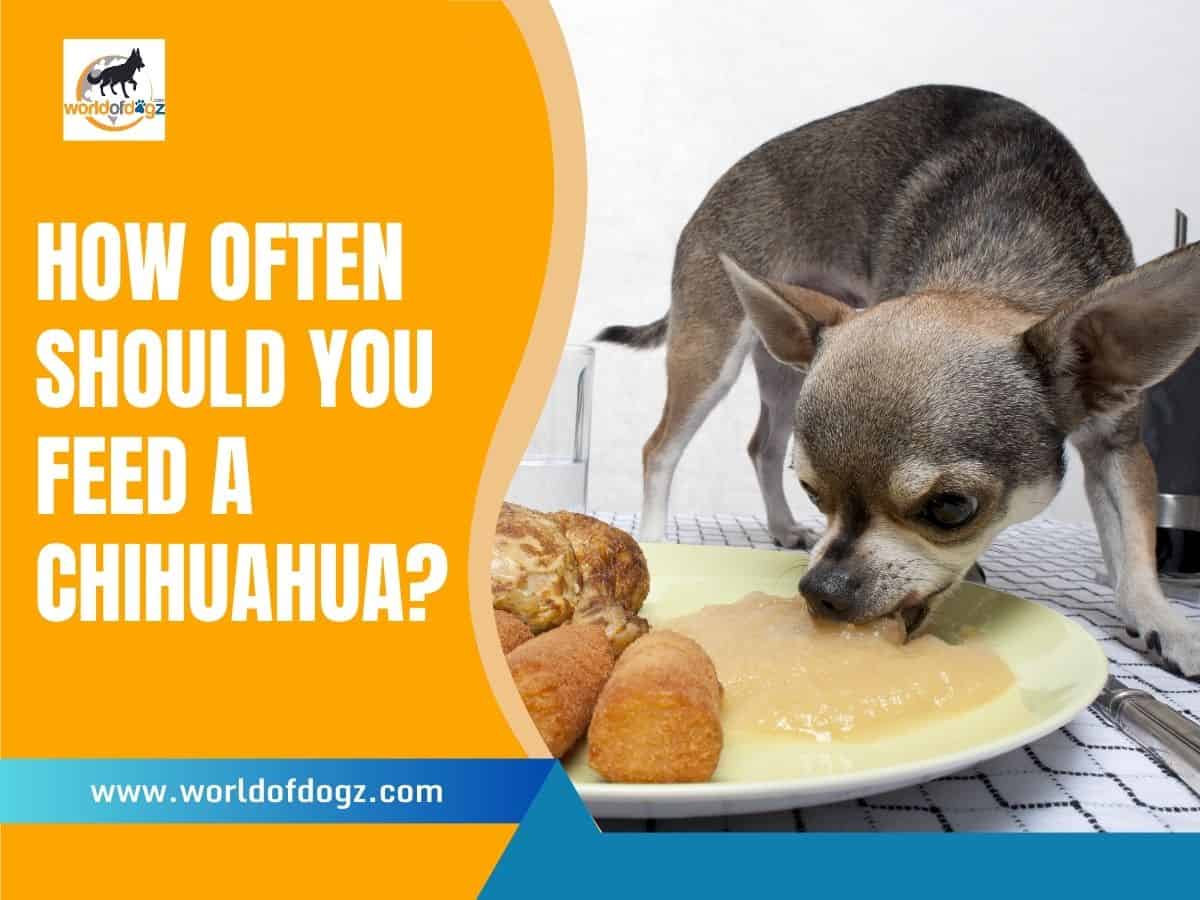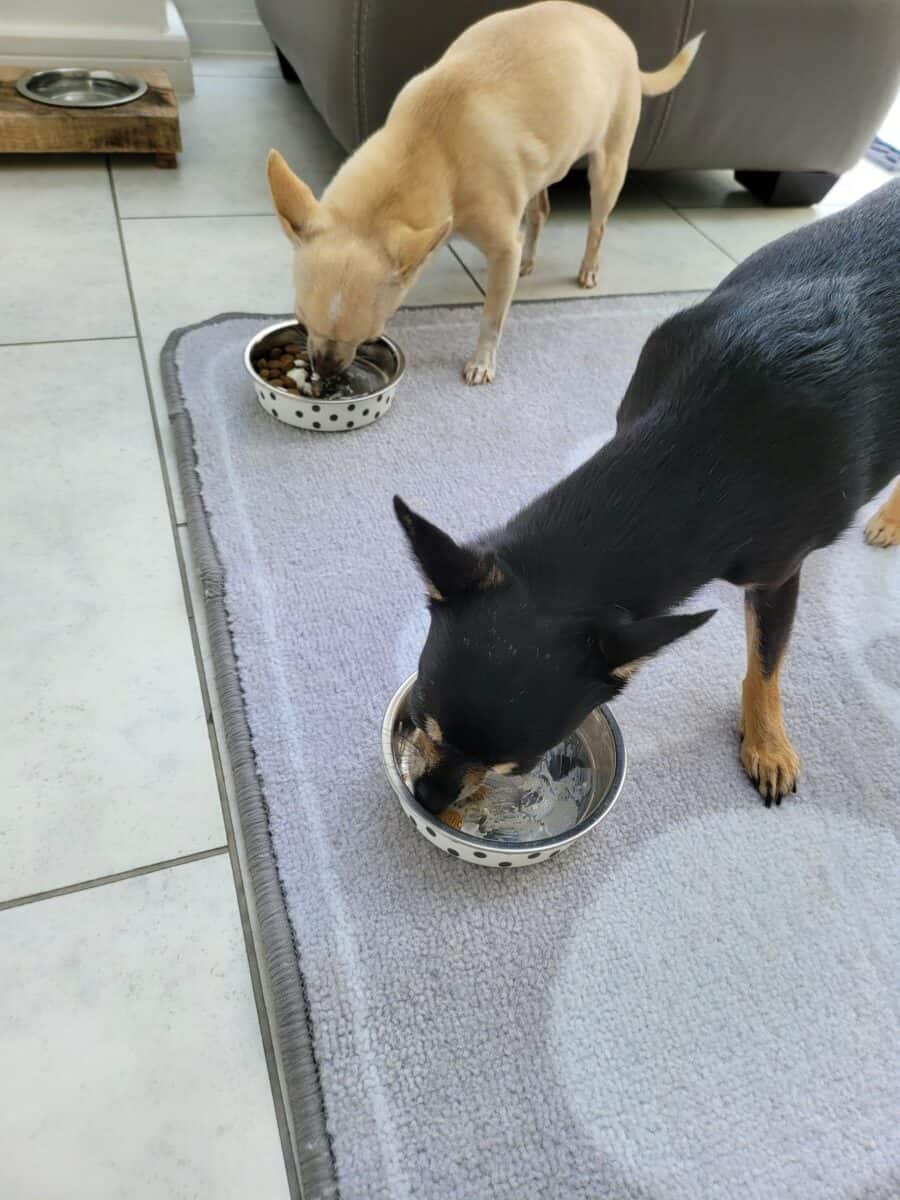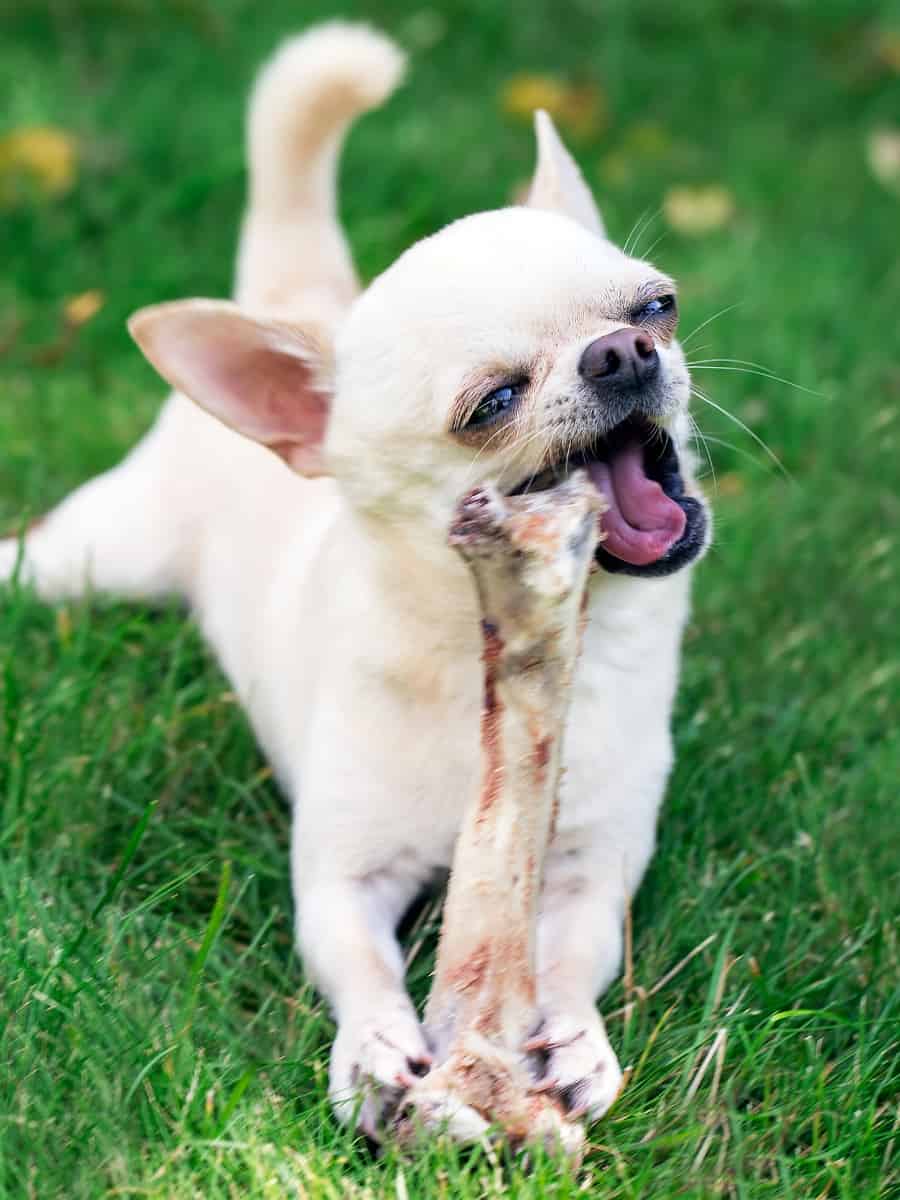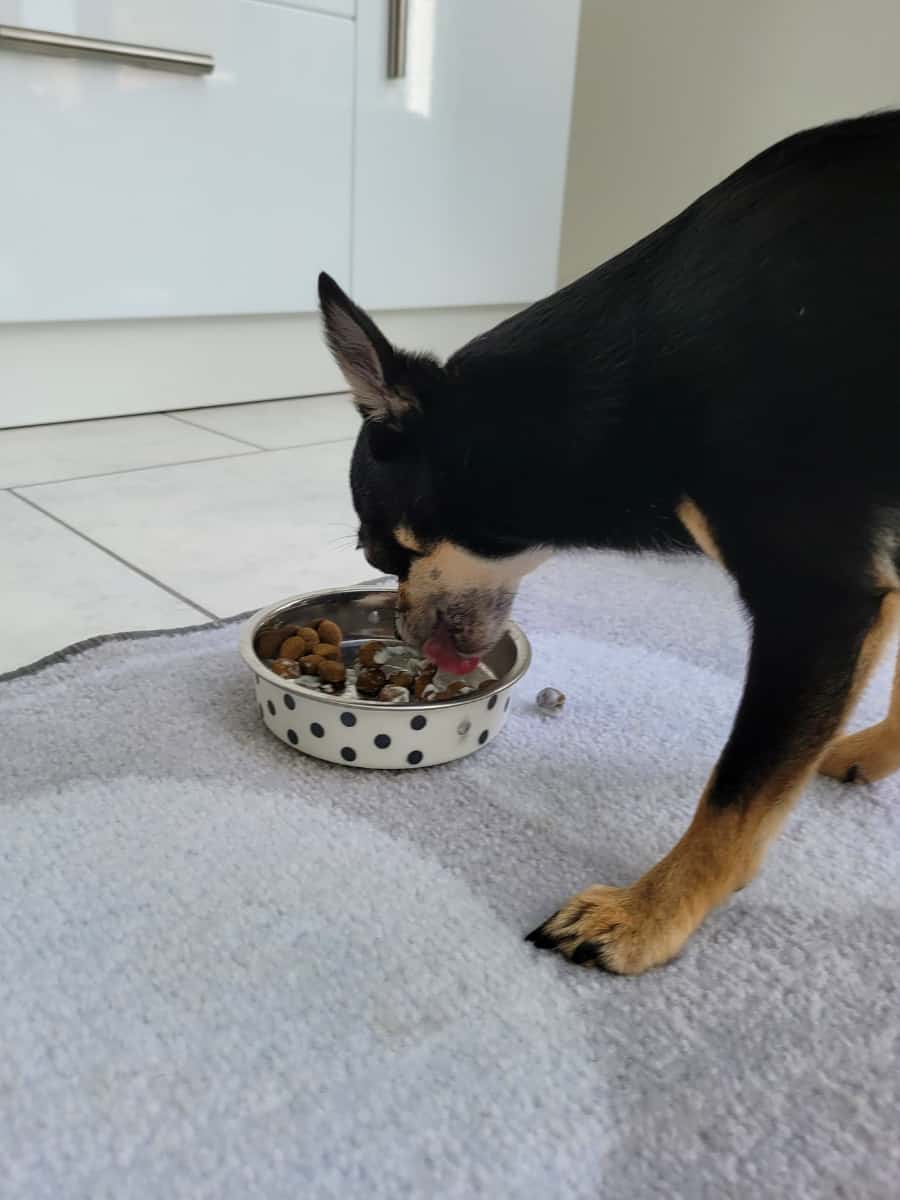Feeding your Chihuahua might seem complicated, but it’s actually quite simple once you understand their needs. If you’re someone like me who has multiple dogs (of varied breeds), it can get daunting at times.
As soon as I rescued my second dog, I decided I needed a quick understanding of the feeding pattern and appetite levels of dogs. And guess what? I cracked it! So, if you have a Chihuahua, you need to know how often to feed the little one.
Adult Chihuahuas should typically be fed three to four times a day, while puppies should be fed around four to six times daily to accommodate their rapid growth and higher energy levels. Don’t overfeed your Chihuahua, as they are prone to obesity and prefer to eat smaller portions throughout the day.
As a rule of thumb, when you get a Chihuahua, educate yourself on their nutritional requirements and discuss a meal plan with a vet. If you have a healthy puppy, you’re free to set a meal plan.
But if you need more help, here’s a guide on what I’ve done to handle my Chihuahuas in terms of meal schedules, how much to feed them, and other considerations you should know.
So, let’s begin!

Chihuahua Feeding Schedule
Chihuahuas are one of the smallest and most beloved dog breeds, making them a popular choice among pet owners. Due to their size, it’s essential to ensure that they receive proper nutrition and follow a suitable feeding schedule. When determining how often and how much to feed your Chihuahua, it’s crucial to consider factors such as their age, size, and energy level.
Puppies have higher energy levels and require more frequent meals to support their growth and development. It is recommended to feed Chihuahua puppies 4 times a day until they are around 3 months old.
As your puppy grows, you can gradually reduce the frequency of meals to 3 times a day until they reach 6 months of age. After that, you can transition them to an adult feeding schedule, which usually consists of 2 meals a day.
So, what makes me suggest these meal numbers?
Size & weight!
Adult Chihuahuas typically weigh between 3 to 6 pounds, according to the American Kennel Club. Depending on their size and activity level, you’ll want to provide them with approximately 40 to 50 calories per pound of body weight daily.
For example, a 5-pound Chihuahua may need 200 to 250 calories each day. This can be divided into 2 equal meals, typically given in the morning and evening, with 12 hours between each meal.
To help you calculate the ideal calories needed for your Chihuahua, I’d suggest using the following calculator:
Sometimes, Chihuahuas might get overly picky and move away from eating what you offer them.
Skipping meals can cause some health concerns for your Chihuahua. Their small size means their stomachs can empty quickly, and they can experience low blood sugar, known as hypoglycemia. Signs of hypoglycemia may include weakness, trembling, dizziness, or even collapse.
In addition to hypoglycemia, irregular feeding can result in obesity, which may lead to health issues such as joint problems, heart disease, and diabetes.
However, you can offer a range of flavors and change their meal plans whenever they turn too picky and unmanageable.

Chihuahua Puppy Feeding Schedule
Chihuahuas have small stomachs and have limited space to store food and energy, making it essential to feed them appropriately. With a proper diet plan, your Chihuahua puppy can grow into a healthy and happy dog.
According to a research article, the canine stomach dilatation capacity for a small dog breed like a Chihuahua is 0.5L, and this is sufficient to understand how small it is to ingest food.
| Age | Number of Daily Meals |
|---|---|
| 2-3 months | 4-5 |
| 4-6 months | 3-4 |
| 7-12 months | 2-3 |
| Over 1 year | 2 |
Following a feeding schedule based on age can help maintain your puppy’s digestion, growth, and overall health. Drastic changes in feeding frequency or amounts can negatively affect a puppy’s digestive system and may cause health issues.
To ensure everything goes well for your Chihuahua puppy in terms of a feeding schedule, follow the guidelines below:
- Increase feeding times based on the activity level.
- Start by offering small, measured meals and adjust as needed to control portions and maintain their ideal weight.
- Establish regular meal times, offer nutritious food, and monitor their growth.
This helps to build a better bond with your puppy over time.
What To Do If Your Chihuahua Won’t Finish His Meal
I’ve witnessed a few times when my little one doesn’t finish her meal. Imagine walking to your dog with yummy, flavorful meals that he/she likes, and they decide to taste it and then move away! Disappointing, right?
“If your Chihuahua hesitates to finish his meal, you aren’t alone! It’s common because the breed is inherently picky and unpredictable.”
Here are the top 5 things you can do to encourage your Chihuahua to finish their meal:
- Monitor portion sizes: Ensure you’re providing the correct amount of food based on your Chihuahua’s age, weight, and activity level.
- Experiment with different foods: Not all dogs have the same taste preferences. Some Chihuahuas might be picky eaters and might prefer foods that are high in protein, fat, or specific flavors. Some love fruits as well. Here’s a list of safe fruits to eat: Fruits safe for Chihuahuas.
- Create a consistent feeding schedule: Chihuahuas often feel more comfortable when fed at the same times each day. This can help reduce anxiety around mealtime.
- Perform health tests: Your Chihuahua’s lack of appetite might be due to an underlying health issue or a nutrient deficiency. A veterinarian can provide guidance on the appropriate diet and supplements to improve their health.
- Encourage slow eating with interactive food dispensers: These dispensers can help make mealtime more engaging, encouraging your Chihuahua to eat at a slower, healthier pace.
Interactive food dispensers are perfect because they promote mental stimulation and help prevent boredom during mealtime.
They often require your Chihuahua to work a bit harder to obtain their food, turning it into a fun and rewarding activity. This can make mealtime more enjoyable and prompt your Chihuahua to eat.
Here’s my dog’s favorite:
- FUNNY DOG TREAT DISPENSER: This interactive dog toy is made for joint games with the dog and you. The dog enrichment toys could provide entertaining play, encourage exercise and improve pets’ memory by rewarding with treats or dry snacks. Friendly sounds play with each push on the Release Button of the dog treat toy to encourage further play (The treats come out! Its a reward!).
- IQ TRAINING INDOOR & OUTDOOR: The dog training tools are not a traditional automatic pet feeder but an IQ training dog toy . The cat treat toy could be placed in remote room, on the wall or the front lawn making the game more fun! The distance between the RELEASE button and host is up to 98 fts in indoor environment and 164 fts in the open air.
- HOW TO USE: Just fill the dry pet treats after opening the adjustable treat dispensing window of the dog puzzle feeder. You just need to try to teach your pets to press RELEASE button on the remote controller. The pet toys for dogs will produce 2 types (A/B) of exciting sounds when your pets successfully fulfills the task. (Then the treat will be released onto the tray).
- DUAL POWER SUPPLY: Install 4 x size C batteries (not included) in the host or connect it via the micro USB cable (not for battery charging) to make PETGEEK interactive food dispensing dog toy work. 3 x AAA batteries (not included) are needed for the remote controller of this dog treat puzzle.We recommend choosing batteries of the same model, brand and material to avoid mixing old and new batteries of different degrees.
- BEST DOG TOY SERVICE GUARANTEE : The interactive dog toy is packed with 1 exquisite colorful box, a good option of pet gifts or dog birthday toys. We guarantee that our dog activity toys will be kept under brand new condition. Please contact us by email directly if you have any problem at anytime. We could refund or resend one replacement after the problem is confirmati
Besides interactive food dispensers, consider incorporating the following nutrients into your Chihuahua’s diet:
- Protein: Important for muscle growth and maintenance.
- Carbohydrates: Provide energy and help maintain a healthy weight.
- Fats: Essential for energy, brain function, and a healthy coat.
- Vitamins and minerals: These support overall health and guard against nutrient deficiencies.
Here’s a list of suggested foods:
Keep an eye on how well your Chihuahua interacts with the rest in terms of behavior, physical movements, and mental stimulation levels. These can give a better understanding of their food requirement.

How Much to Feed a Chihuahua
So, we’ve taken a look at the feeding schedule and calories required for your tiny, cute Chihuahua each day. What next?
Similar to humans, portion control is crucial for dogs. A lack of portion control results in undereating or overeating in dogs. As a result, they may end up with other health conditions.
So, what’s the solution? Head on!
Generally, Chihuahua puppies should be fed 3 to 4 small meals per day. You can start with 1/4 cup of food per meal and adjust depending on their appetite and growth rate. As they grow older, you can gradually transition them to adult dog food.
Adult Chihuahuas typically consume less food in a day than puppies as their growth rate slows down. An average adult Chihuahua should be fed around 1/2 to 1 cup of food per day, split into two meals.
So, do these numbers work for all types of diets?
Dry kibble is often recommended for Chihuahuas due to its convenience, affordability, and dental benefits. However, wet food and raw food diets can also be suitable options as long as they provide balanced nutrition.
You should choose a high-quality brand that focuses on using natural ingredients without excessive fillers and artificial preservatives.
Here’s my Chihuahua’s favorite wet food:
- FORMULATED FOR PUREBRED CHIHUAHUAS: Royal Canin Chihuahua Wet Dog Food is designed to meet the nutritional needs of purebred Chihuahuas 8 months and older
- TASTY LOAF IN SAUCE: Highly palatable soft dog food, featuring Loaf in Gravy with moderately high fat and energy density, helps satisfy picky eaters
- SKIN AND COAT: Omega-3 EPA and DHA and biotin support skin and coat health
- OPTIMAL STOOL: Small breed dog food helps reduce stools and stool odor with soluble and insoluble fibers to support a healthy intestinal transit
- COMPLETE AND BALANCED: Wet food in convenient pouch can be fed alone as complete and balanced diet or mixed with Royal Canin Adult or Adult 8 plus Chihuahua Dry Dog F
Thinking of raw feeding your Chihuahua? Watch this video:
Chihuahua Meal Plan
A meal plan is crucial for your Chihuahua’s overall well-being and long-term health. Tailoring their feeding schedule and portions to accommodate their size, weight, and activity level ensures they receive the right nutrients and maintain a healthy weight.
When determining the amounts for your Chihuahua’s meal plan, consider their exercise and activity level. The following table offers a guideline based on an adult Chihuahua’s weight, with columns dedicated to low, medium, and high activity levels.
| Adult Weight | Low Activity | Medium Activity | High Activity |
|---|---|---|---|
| 2 lbs | 1/4 cup | 1/3 cup | 1/2 cup |
| 4 lbs | 1/2 cup | 2/3 cup | 3/4 cup |
| 6 lbs | 3/4 cup | 1 cup | 1 1/4 cups |
So, what to feed each time? I know some dogs don’t like packaged foods. Instead, they look out for homemade foods. If you’re a fan of the latter, too, check the table below.
| Day | Meal 1 | Meal 2 | Meal 3 |
|---|---|---|---|
| Monday | Turkey & Chicken | Chicken & Broccoli | Lamb & Sweet Potatoes |
| Tuesday | Chicken & Brown Rice | Beef & Carrots | Turkey & Chicken Meal |
| Wednesday | Turkey & Chicken Meal | Chicken & Broccoli | Lamb & Sweet Potatoes |
| Thursday | Chicken & Brown Rice | Beef & Carrots | Turkey & Chicken Meal |
| Friday | Turkey & Chicken Meal | Chicken & Broccoli | Lamb & Sweet Potatoes |
| Saturday | Chicken & Brown Rice | Beef & Carrots | Turkey & Chicken Meal |
| Sunday | Turkey & Chicken Meal | Chicken & Broccoli | Lamb & Sweet Potatoes |
I’m sure you’ll find this easy to plan ahead. Of course, you can swap or remove some based on your dog’s preference.
Health Considerations
Obesity in Chihuahuas
Chihuahuas can be prone to obesity if not given proper nutrition and portioned meals. Overweight Chihuahuas may experience various health problems, such as joint issues, heart disease, or diabetes. To prevent obesity in your Chihuahua, pay attention to their dietary needs and consult with a canine nutrition expert.
Feeding your Chihuahua an appropriate amount per day, usually measured in ounces, will help maintain their ideal body condition.

Underweight Chihuahuas
On the other hand, underweight Chihuahuas are also prone to health concerns, such as low blood sugar, poor immune function, and digestive issues. To help your little Chihuahua gain weight in a healthy manner, ensure that they are receiving enough nutrients and calories in their daily meals.
Regularly feeding your Chihuahua small portions throughout the day can help prevent blood sugar dips, which are particularly concerning for underweight or toy breeds. Small, frequent meals will also help prevent overloading their little stomachs, decreasing the risk of digestive issues.
FAQs
Is dry or wet food better for a Chihuahua?
Both dry and wet food options have their advantages and disadvantages for Chihuahuas. Dry food is more convenient and helps to keep their teeth clean, as the kibble can scrape away plaque. On the other hand, wet food is easier to digest and provides more hydration, which can be beneficial for smaller dogs like Chihuahuas.
Your pet’s individual needs and preferences will determine which option is better for them.
What should be the ideal weight of a Chihuahua?
The ideal weight of a Chihuahua can vary depending on factors such as gender, age, and overall health. However, adult Chihuahuas typically weigh between 3 and 6 pounds. Maintaining a healthy weight for your Chihuahua is vital to avoid health issues like joint problems, obesity, or heart disease.
How to determine the right food portion for a Chihuahua puppy by weight?
Chihuahua puppies require more calories per pound of body weight than adult dogs, as they need the energy for growth and development. A popular feeding guideline is to offer approximately 50 calories per pound of their body weight daily. This is just a guideline, and individual differences may apply.








